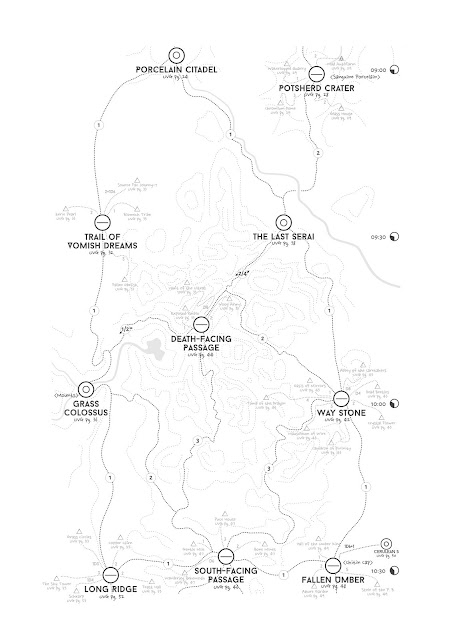PDF Link. This document includes:
- Fighter, Barbarian, Thief, and Hunter from Many Rats on Sticks.
- 5 Wizard Types. Some spells based on existing ones, but a sprinkling of new ones too.
- Entirely new Polybody, Vome, and Warlock classes, with associated useful tables.
A UVG price list (including pets). - A handy condensed character sheet, time tracking sheet, and hireling sheet.
- And much more!
Even if you don't use the GLOG bits, there's a decent chance some tables in this document will help your UVG games.
XP System
Choosing how to award experience points changes your game experience.My preferences (for most games) are:
-Ultraviolet Grasslands
- Acquisition of XP should require some player skill.
- Acquisition of XP should not occur by default. It should require positive action, overcoming obstacles, or making critical choices.
How well do different methods in Ultraviolet Grasslands meet these requirements?
New Location: XP for Traveling to Discovery Sites
In UVG, the PCs travel from location to location. When they reach a new location, a hero tests to locate Discoveries: side-sites, dungeons, or points of interests. If they choose to visit a Discovery, they gain some XP (ranging from 30 to a few hundred); not insubstantial when 300xp gets you a level.
Technically, discoveries are not available by default, but there's no player skill involved in uncovering them. It's just luck of the dice. Visiting them is not really risky. Travel in the UVG is assumed to succeed; failure is possible but (unless everyone I've seen running it has missed something) has very little to do with player skill.
Rating: Maybe Suitable
New Organism: XP for Describing a Creature or Survey Site: XP for Describing a Location or Investigate Anomaly: XP for Describing an Anomaly
This isn't really a player skill. It's a fun idea, but is this why people turned up to D&D night? Who's doing the describing. The players, who in most D&D-type games have less than total control over some aspects of the fiction, or the GM, who has enough to do without describing the life cycle of the boa-rat? XP for the player inventing purple prose or XP for listening to the GM's purple prose?
Rating: Not Suitable
New Anomaly: XP for Encountering a New Thing
Difficult to adjudicate; trickier still if wizards can conjure solid light or stuckforce. Hard to remember too. Requires no skill; the PCs just need to show up and go "oooh".
Rating: Not Suitable
XP for Combat
In UVG, XP is awarded based on surviving conflicts. Again, that's the default state. Victory or dealing the final blow gets you some bonus XP. That does require some player skill, and isn't the default state... but there's a problem. XP for kills leads to violence being the default answer. It can also lead players to try to win fights when they know they should retreat, and can lead to frustration when fights go wrong or enemies turn out to be very tough. "We're trying to do the thing that you set as a victory condition, GM. Why are we being punished for it?"
Rating: Maybe Suitable
XP for Carousing
I like this idea, even if it doesn't fit player skill paradigm. PCs often end up with far too much cash. Converting some into XP via irresponsible decisions is a good plan. It's gold for XP with an extra step. But XP for carousing can only support an existing core XP mechanic; it can't replace it.
Rating: Suitable (but supplemental).
Quest XP
There are 14 "big" quests on UVG pg. 147. Complete one and you get a chunk of XP. It's a good idea - none of the quests can be completed by default, and all require some degree of player skill. Some will warp the playstyle of the game (like the XP for Elephants method above). Others only deliver XP once in a huge lump. It's a mixed bag. Having a big quest isn't the worst idea if players have trouble self-directing.
Rating: Maybe Suitable
Conclusion
What the heck am I going to use in Ultraviolet GLOGlands?Gold for XP is good, but it doesn't encourage exploration. If anything, it encourages finding a rich site and "mining" it for gold for several sessions. As much as I like it, I don't think it's the right core XP system for this game.
XP for Discoveries is mediocre because discoveries require minimal player skill. I'm going to augment it as follows:
-XP for reaching a Discovery.
-XP for fully exploring or mapping a discovery or figuring out what's going on.
So just turning up gets you 1x XP, but spending time exploring gets you 2x XP. How the PCs explore or figure out what's going on is left ambiguous. Smart play is encouraged.
On top of that, XP for Carousing will help deplete some of that excess gold and encourage irresponsible decisions.
EDIT
If this system is too complicated and you'd like an alternative to SEACAT, try Victor Carity's ultra-basic BASICAT. Or if you want a completely different style, try Mike Ferdinando's UltravioletWorld Apocalypse World hack.




























